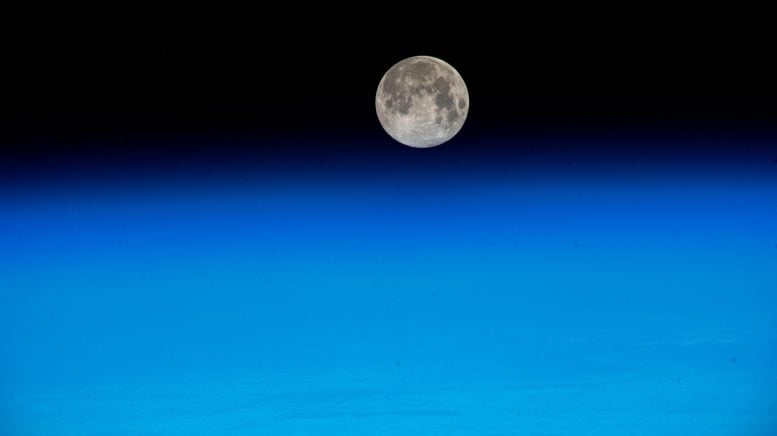
The near Full Moon is pictured just above Earth’s atmosphere in this photograph from the International Space Station as it orbited 262 miles above the Pacific Ocean off the coast of Japan. Credit: NASA
The work week kicked off with drug therapy research and DNA analysis aboard the International Space Station (ISS) to promote health on Earth and in space. The seven Expedition 70 crew members also had time for advanced technology studies including robotics, fiber optics, and future piloting techniques.
NASA Flight Engineer Loral O’Hara explored ways to optimize treatment methods for breathing conditions on Earth. She treated samples inside the Harmony module for the investigation that may advance health therapies and prevent tubing contamination for liquid flows. NASA Flight Engineer Jasmin Moghbeli extracted DNA to identify bacteria collected from station water samples. Moghbeli’s work is demonstrating hardware that can analyze microbes to protect crew health and spacecraft life support systems on future missions.
NASA astronaut and Expedition 70 Flight Engineer Jasmin Moghbeli configures spacewalking tools inside the International Space Station’s Quest airlock. Credit: NASA
O’Hara and Moghbeli teamed up Tuesday morning for an Instagram Live event with NASA and ESPN. The duo discussed life in space and the ability to watch live sports on the orbital outpost.
ESA (European Space Agency) Commander Andreas Mogensen observed an Astrobee robotic free flyer as it maneuvered throughout the Kibo laboratory module. Scientists on the ground also monitored as the toaster-sized device used a perching arm to grapple handrails and move inside the station rather than use propellant. Mogensen also worked on virtual reality hardware supporting an experiment to overcome isolation and confinement on long-term space missions.
Two Astrobee free-flying robotic assistants are pictured during an experiment demonstrating how the toaster-sized robotic devices can use a small robotic arm and grasp handrails to maneuver throughout the space station. Credit: NASA
Flight Engineer Satoshi Furukawa from JAXA (Japan Aerospace Exploration Agency) wrapped up an experiment that Mogensen had started earlier in the day to study the ability to manufacture superior fiber optic cables in microgravity. Furukawa also worked throughout Monday servicing exercise gear, life support hardware, and tablet computers.
Roscosmos cosmonaut Oleg Kononenko strapped on a sensor-packed helmet and practiced futuristic piloting techniques on a computer during the morning. The five-time station astronaut then spent the afternoon inventorying cargo in the station’s Roscosmos segment.
Flight Engineer Nikolai Chub worked on interior panels inside the Zvezda service module before conducting fluid physics research. Flight Engineer Konstantin Borisov downloaded data from a physics experiment to a laptop computer, worked on drill batteries, and then filled an oxygen generator tank.
>>> Read full article>>>
Copyright for syndicated content belongs to the linked Source : SciTechDaily – https://scitechdaily.com/dna-decoding-and-robot-rendezvous-the-latest-scientific-innovation-on-the-space-station/